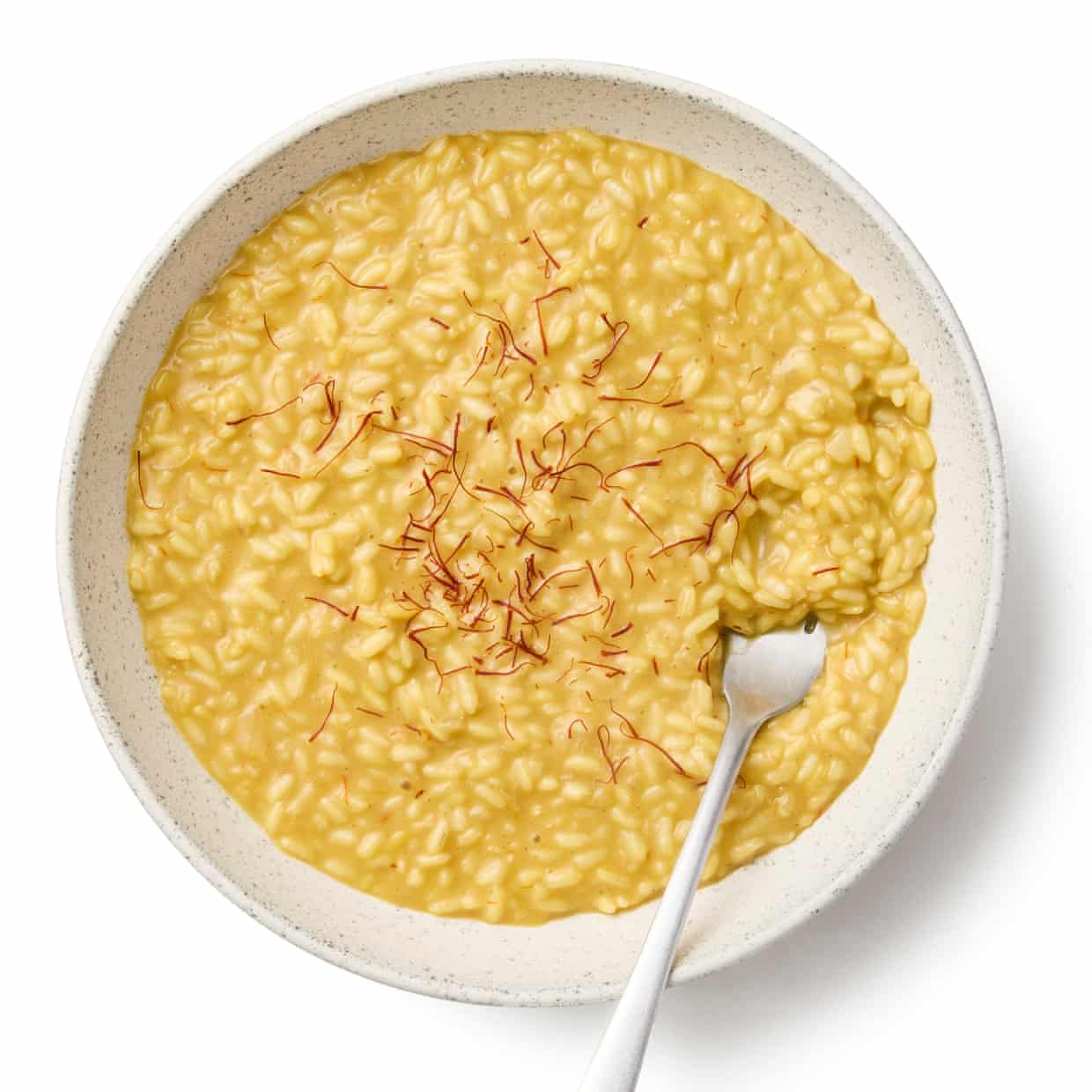How to make risotto alla milanese – recipe | Felicity Cloake's Masterclass

Risotto alla milanese is, like the city it calls home, elegantly simple, but very rich.The saffron that gives the dish its striking colour is rightly expensive (it takes about 150 flowers to produce a mere gram), but you don’t need much and, though it’s often served alongside osso buco, I think it makes a fine meal on its own with a bitter-leaf salad.Prep 5 min Cook 30 min Serves 41 onion 75g butter, or 15g butter plus 60g bone marrow350g risotto rice (carnaroli, arborio, vialone nano)1 litre beef stock, or chicken or vegetable stock75ml dry white wine (see step 4)1 level tsp saffron threads75g finely grated parmesan, or grana padano or a vegetarian alternativePeel and finely chop the onion; the aim is for it almost to disappear into the dish, rather than remaining as distinct chunks, so take your time over doing this (you could substitute two shallots, if you prefer – their sweetness works particularly well with the flavour of the wine and cheese).Melt a generous tablespoon of the butter in a frying pan set over a medium-low heat, then fry the chopped onion until soft, golden and limp, but not coloured.Turn the heat up to medium-high, add the rice and fry, stirring constantly, until the grains are hot and starting to turn translucent around their edges.
Meanwhile, bring the stock to a gentle simmer on the hob,Beef is the traditional choice with osso buco, but you may prefer to use a chicken or vegetable-based example, or simply water down the beef stock for a slightly lighter dish,Conversely, for a beefier result, substitute some of the butter with bone marrow from the butchers,Once most of the rice grains are semi-translucent, pour in the wine (it should hiss when it hits the pan) and leave to bubble away until it’s almost all evaporated,You could also use dry vermouth or sherry here, if that’s what you have to hand, or indeed leave out the alcohol altogether, as many local Milanese recipes do.
Stir in a ladleful of hot stock, then leave to cook until it’s all been absorbed (there’s no need to stir at this point).While you wait for that, lightly crush most of the saffron threads in a mortar (keep a few back to use as a garnish later), then pour in a little of the hot stock and leave to steep and infuse.Keep adding ladlefuls of hot stock for about eight minutes, waiting until each one is absorbed before adding the next, and begin stirring the rice as you do so.Keep going until the rice is just a little al dente for your taste; classically, it should still have some bite in the centre, but that’s up to you.If you run out of stock, switch to hot water.
Stir in the saffron-infused stock.Risotto should have a loose texture that’s more like porridge or a loose rice pudding than anything capable of holding its own shape; if yours feels a little on the stodgy side, stir in a little more stock or water as your taste dictates (try it before deciding, though, because you might find it rich enough as it is).Add the remaining butter or bone marrow to the risotto, along with the grated cheese; grana padano is the local option.Cover and leave to sit for a couple of minutes, then vigorously beat the risotto until it turns creamy.Season to taste (you may well not need any more salt), garnish with the reserved saffron and serve at once in hot shallow bowls.
Alternatively, to get ahead, after the first eight minutes of cooking the rice in stock, spread out the rice in a single layer on a large baking tray.Leave it to cool, then transfer to a suitable container, cover and chill.When you’re ready to eat, simply return the rice to the pan, heat both it and the stock back up and continue with the recipe as written.

How to make risotto alla milanese – recipe | Felicity Cloake's Masterclass
Risotto alla milanese is, like the city it calls home, elegantly simple, but very rich. The saffron that gives the dish its striking colour is rightly expensive (it takes about 150 flowers to produce a mere gram), but you don’t need much and, though it’s often served alongside osso buco, I think it makes a fine meal on its own with a bitter-leaf salad.Prep 5 min Cook 30 min Serves 41 onion 75g butter, or 15g butter plus 60g bone marrow350g risotto rice (carnaroli, arborio, vialone nano)1 litre beef stock, or chicken or vegetable stock75ml dry white wine (see step 4)1 level tsp saffron threads75g finely grated parmesan, or grana padano or a vegetarian alternativePeel and finely chop the onion; the aim is for it almost to disappear into the dish, rather than remaining as distinct chunks, so take your time over doing this (you could substitute two shallots, if you prefer – their sweetness works particularly well with the flavour of the wine and cheese).Melt a generous tablespoon of the butter in a frying pan set over a medium-low heat, then fry the chopped onion until soft, golden and limp, but not coloured.Turn the heat up to medium-high, add the rice and fry, stirring constantly, until the grains are hot and starting to turn translucent around their edges

2210 By Natty Can Cook, London SE24: ‘Much more than just posh jerk chicken at fancy prices’ – restaurant review | Grace Dent on restaurants
There’s an attention to detail in every dish that makes this place more than fit for a special occasionIt’s 6pm in Herne Hill, south-east London, and I’ve popped out for some Caribbean food wearing fancy athleisure wear. Yoga trousers and a smart hoodie, but PE kit nonetheless. And, once I arrive at 2210 By Natty Can Cook, I realise I am severely underdressed.When chef Nathaniel Mortley announced that he was opening a restaurant that aimed to celebrate Caribbean culture “in style” and to win a Michelin star, his loyal Instagram following, as well as their families and friends, took the brief and dressed accordingly. As fancily plated ackee and saltfish spring rolls passed by, as well as a lot of rum punch, I rustled in my handbag for some bigger earrings and more makeup

‘Simple, well-crafted and excellent’: supermarket chutneys, tasted and rated | The food filter
Our resident taster dipped, spread and dolloped his way through 10 chutneys in time for Christmas, so you don’t get in a pickle choosing one for yourself The fair price for 14 everyday items, from cleaning spray to olive oilThe Guardian’s journalism is independent. We will earn a commission if you buy something through an affiliate link. Learn more.Chutney is a heritage recipe that’s been largely unchanged for a century, and some of the best versions are the simplest and most traditional. That said, even when it’s made on an industrial scale, chutney usually features just fruit, sugar, vinegar and perhaps some pectin

It’s not all about roasting on an open fire – there’s so much more you can do with chestnuts
If I’d ever spared a thought for how chestnuts – the sweet, edible kind, not the combative horsey sort – were harvested, I would probably have conjured rosy-cheeked peasants bent low in ancient forests and filling rough-hewn hessian sacks by hand. Back-breaking labour, sure, but so picturesque!I was delighted, therefore, while on a writing retreat in Umbria last month, to get the opportunity to watch an elderly couple manoeuvre a giant vacuum around their haphazard orchard, followed by their furious sheepdog. The fallen crop was sucked into a giant fan that spat their bristly jackets back out on to the ground, and the nuts then went to be sorted by other family members on a conveyor belt in the barn – the good ones to be sold in the shell, the less perfect specimens swiftly dropped into a bucket for processing.Later in the week, a lorry turned up in the village square to pick up bags from other small local producers, and that evening I roasted a pan of chestnuts on the fire with new appreciation, while loudly bemoaning the disappearance from the streets of London of the chestnut sellers of my childhood (though this makes me sound positively Dickensian, I can confirm that I’m talking about this century. Note also that Nigel Slater is less starry-eyed on the subject

Benjamina Ebuehi’s recipe for apple, brown butter and oat loaf | The sweet spot
I adore a good loaf cake. There’s something about them that’s just inherently cosy and wholesome, and this one in particular is perfect for the colder months, not least because it’s simple and sturdy in the very best way. It’d be right at home with a coffee for breakfast, as well as gently warmed in a pan with butter and served with hot custard on a rainy evening. A real all-rounder.Prep 5 min Cook 1 hr 25 min Serves 8180g unsalted butter 200g light muscovado sugar 2 large eggs 50g soured cream 210g plain flour ½ tsp cinnamon 40g porridge oats, plus extra to finish1½ tsp baking powder ¼ tsp salt 2 eating apples 2 tbsp demerara sugarHeat the oven to 180C (160C fan)/350F/gas 4 and grease and line a 2lb loaf tin

Kids have a wobble in the face of rabbit jelly | Brief letters
I sympathise with Tim Dowling and the challenges of releasing blancmange from a rabbit mould (Jelly’s back! Here are three worth making – and three that should wobble off to the bin, 12 November). My mistake was adding chopped pineapple to the jelly mix, with the resulting jelly looking as though we were seeing the undigested contents of a rabbit’s stomach. My children refused to eat it.Dee ReidTwyford, Berkshire Tim Dowling has missed out one important ingredient from his otherwise commendable recipe for blancmange rabbit: the two sultanas you stick on for the eyes.Jane GregoryEmsworth, Hampshire Regarding concerns over Epstein Road in Thamesmead (Letters, 12 November), spare a thought for those unfortunate residents of Savile Row in central London

Woman killed herself after south London hospital neglect, coroner concludes

‘It’s cruel’: relatives of residents react to proposal to close Lancashire care homes

Why is social mobility such an obsession? | Letters

‘Better and cheaper’: the case for prostate cancer screening among black men

Stephen Dawson obituary

Two-thirds of nurses in UK work while unwell, says union